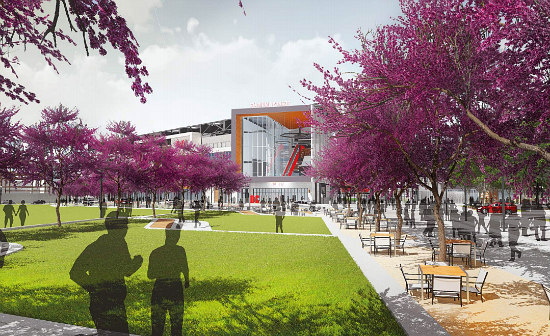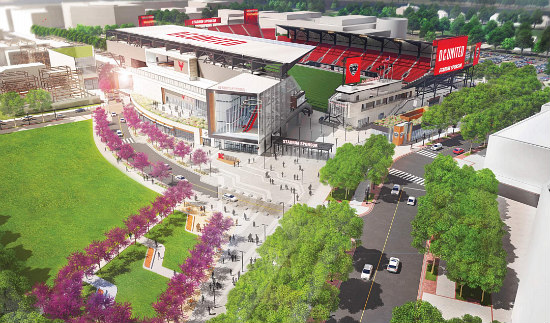DC UrbanTurf by Nena Perry-Brown

Last month, the Zoning Commission decided to postpone final action on DC United’s new stadium until February in order to ensure that the local ANC and community members have their concerns addressed by the developer and city government agencies.
On Monday, the development team, Office of Planning (OP), District Department of Transportation (DDOT), Department of Energy and the Environment (DOEE) and the Department of Health (DOH), submitted their responses on the record.
The planned DC United soccer stadium in Buzzard Point (map) would serve as a major neighborhood anchor and as the new home of DC’s soccer team after their lease at RFK Stadium expires in 2019.
After meeting with ANC 6D earlier this month, developer Akridge and architecture firm Populous furnished a preliminary transportation operations and parking plan (TOPP) to outline what the final TOPP will address, from gameday management of transportation and curbside flow to signage and placement of traffic control officers (TCOs).
Specific suggestions in the preliminary TOPP include placing TCOs where South Capitol Street intersects with N and P Streets and with Potomac Avenue, using “dynamic signal timing” on gamedays, and widening the sidewalk along Potomac Avenue west of South Capitol. Transportation scenarios will also be broken down for low-attendance games (with about 4,000 spectators), moderate-attendance games (with 4,000-12,000 spectators) and high-attendance games (with over 12,000 spectators). In all cases, 40 percent of the attendees are expected to arrive by transit, 55 percent are expected to drive, two percent are expected to bike, and one percent each are expected to walk, utilize a “hired vehicle” or use some other means of transportation.
At least 42 permanent short-term bicycle racks will be constructed on stadium property and an additional 57 racks will be on the public space surrounding the stadium. On high-attendance days, extra temporary bike parking will also be provided. Protected two-way bike lanes are planned for Maine Avenue, 2nd Street and Potomac Avenue/R Street.
Navy Yard Metro station is still envisioned as the primary Metro for the new stadium and will contain DC United-specific signage. The team plans to coordinate with DDOT, the Washington Metropolitan Area Transit Authority (WMATA) and DC Circulator to explore either expanding a current bus route or adding a new one to serve the stadium roughly a year before the stadium opens. The plan also contains maps showing suggestions block-by-block for on-street parking restrictions — including some mix of metered on-street parking within walking distance of the stadium.

Based on the commission’s encouragement, the plan also includes the potential to have a water taxi bring game attendees from National Harbor or Alexandria to the new stadium. The developers are in talks with Potomac Riverboat Company, which already runs 2-3 boats to Nationals Park, to come to an agreement to add to gameday transportation options. A dock would potentially be located on Buzzard Point at First Street, or the passengers could offload at Diamond Teague Park where Nationals stadium is located.
The TOPP reiterated DC United’s intent to avoid scheduling games concurrently with Nationals games; however, their plan mentions that if such a conflict were to arise, the game times could be staggered to allow attendees of a United game to vacate the area before Nationals’ game attendees arrived.
The development team will continue engaging with major stakeholders, the community and DDOT in order to release a draft TOPP roughly six months before opening day for feedback and comments.
Populous also addressed the Commission’s question of whether the large signs on the exterior of the stadium were designed as a substitute for architectural interest by stating that the signs enhance the experience of the stadium while maximizing its ability to generate revenue. In response to neighborhood concerns about the environmental remediation process during construction, the developers said they will contribute $50,000 to BreatheDC to purchase and distribute air purifiers to nearby residents. The developers also offered estimates on the decibel levels of the game in order to assuage the Commission’s apprehension over the noise that the stadium will generate.
In addition to the development team, OP, DDOT, DOEE and the DOH offered point-by-point responses to ANC 6D’s concerns, with acknowledgement and defense of their community engagement levels a frequent refrain. One point of contention was whether DDOT had based their analysis of the feasibility of the stadium on delivery of a streetcar stop to the area; while DDOT acknowledged that their Special Events Study did assume the presence of a streetcar, only 8.5 percent of transit trips were apportioned to that mode, making the current plans still valid. OP agreed with the ANC that the Commission should put a restriction in their order for DC United not to install digital signage outside the stadium, although the developers would still be able to apply for a planned-unit development modification if they wanted to add electronic signs in the future.
The Zoning Commission is expected to make their final decision on the stadium on February 16th.


